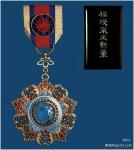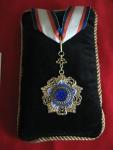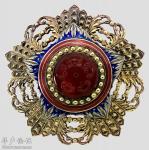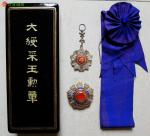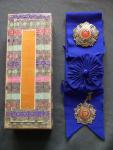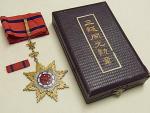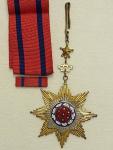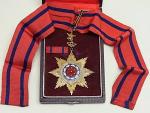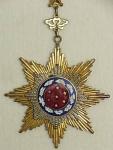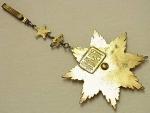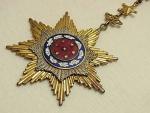-
Posts
851 -
Joined
-
Last visited
-
Days Won
3
Content Type
Profiles
Forums
Blogs
Gallery
Events
Store
Everything posted by drclaw
-
Thanks for posting this. I didn't know that ROK troops participated in Vietnam. Were there many?
-
Thanks for posting the images of the Wu Bei Fu medals. The Spink April 2011 auction had what I believe to be a complete set of these. The catalogue descriptions for the different medals were: * Medal for Public Affairs and Public Service - rayed medal * Medal for Technical Superiority - rayed medal * Medal for Good Conduct - rayed medal * Merit Medal for Shooting - circular medal * Commendation Medal - hexagonal medal with Wu's portrait framed by a six-pointed star Otherwise, there's very little information in English I am aware of on these medals, i.e. date of institution, etc.
-
Thanks Lambert for the info. I'm pretty sure reproduction or even genuine ribbons (they were used for many medals during the Early Republic period) are readily available in China and may appear from time to time on ebay.
-
Thanks Nick. The images show nicely the vinyl / paperboard construction of the presentation case as common in many of the other awards of the Reorganised Government of China. When we compare this to the presentation cases of even "lowly" Japanese awards, the modest quality of this award really does underline the circumstances of the puppet government.
-
Wang Zhengting (1882-1961) Wang Zhengting was a Chinese diplomat. His father was a Methodist Minister and Wang graduated from Yale with law in 1910. He was a Chinese delegate under Wellington Koo at the Paris Peace Conference in 1919. He served as Foreign Minister and Finance Minister in the Beiyang Government, and then Foreign Minister under the Nationalists until 1931 when he was attacked by student protestors who blamed him for China's weak response to the Mukden Incident and hospitalised. He later served as Ambassador to the US from 1936-38. After the defeat of the the Nationalists in 1949, Wang elected to stay in Hong Kong rather than follow the Chiang Kai-shek and his government to Taiwan.
-
Here are some images sourced from Chinese websites. Someone with better Mandarin that me might be able to translate the first two characters on the presentation case of the rosette breast badge. Note the neck badge had two blue rings while the others have one blue ring. Peterson describes the colour of the jade as dark green, but it appears more blue.
-
The description - "Special Cravat" vs. "Cravat" and "Special Rosette" vs "Rosette" - suggests the possibility that the Third Class and Fourth Class might have been split into two sub-classes. In the Order of the Golden Grain - which the 9-Class Order of the Brilliant Jade replaced - the 2nd Class was split into a sash badge and breast star award, and a breast star only award. While a very useful resource, the China Year Book is not always 100% correct. For example, the 1921-22 Year Book makes no mention whatsoever of the Order of the White Eagle in its overview on the Orders of the Early Republic. Again, only the original statutes would confirm this. But in the absence of these, we can still make educated guesses based on the available literature and specimens.
-

Russian Federation II class Order of St.George of General Makarov
drclaw replied to JapanX's topic in Russian Federation
Thanks for posting these Nick. I like how Russia is re-introducing the old Tsarist Orders. It would be even better if they resurrected old firms like Keibel and Eduard to make them -
There appears to be some confusion as to the insignia / classes of the 9-class order, particularly the first three classes. According to Peterson, insignia for the 1st and 2nd Class is very similar with the red centre jade except that the 1st Class has three red rings surrounding the centre medallion while the 2nd Class has two red rings. The 3rd Class, worn as a neck badge, has only a single red ring. The Fourth, Fifth and Sixth Classes had dark green jade (again, with three, two and one circular rings). The Seventh, Eighth and Ninth Class were white (with three, two and one circular rings). Peterson states that the sash for the First Class was red, the Second Class white with red edges, and the Third Class blue (he refers to it as a neck cravat however it was also a sash, see below). The example in Li Gongqing's book includes both a red jade sash badge and breast star with ONE circular ring which he describes as a 3rd Class. So it seems the Third Class was also a sash set although one possibility is that it was the 2nd Class, i.e. Grand Cordon, 1st Class, 2nd Class … Unfortunately, Li Gongqing's example does not include the presentation case whose inscription would confirm the class. JCwater's website also has an exquisite Third Class. I've taken these images from his site - http://www.jcwater.net/show.asp?id=1097 Note the ONE circular red ring surrounding the centre medallion. http://gmic.co.uk/uploads/monthly_05_2014/post-11630-0-44876000-1399074406.jpghttp://gmic.co.uk/uploads/monthly_05_2014/post-11630-0-44294500-1399074454.jpg Here is an example of a Second Class breast star. Note the TWO circular red rings surrounding the centre medallion. Now, here are three specimens where the inscription on the presentation cases is da shoo or "grand cordon". The third example is from the recent Hong Kong Poly auction. HOWEVER, all the insignia only have ONE circular ring like the 3rd Class and the same dark blue sash. http://gmic.co.uk/uploads/monthly_05_2014/post-11630-0-33874500-1399075106.jpghttp://gmic.co.uk/uploads/monthly_05_2014/post-11630-0-55337300-1399075154.jpghttp://gmic.co.uk/uploads/monthly_05_2014/post-11630-0-11485700-1399075951.jpg One explanation is that the same presentation cases were issued for the 1st, 2nd and 3rd Classes as they were all sash sets or "Grand Cordons". Peterson wrote that the sizes for the 1st and 2nd Class were the same - 80mm for the badge, 93 mm for the star. So they would have all fit within the same case housings. Only the original statutes will clarify this confusion. Unfortunately, I don't have these. If we accept the theory that the same presentation cases were issued for the 1st, 2nd and 3rd Classes, going back through some of the London / European auctions and using Peterson's three-, two-, one-ring description, the most commonly encountered insignia were the 3rd Class. * Spink April 2011 - one ring, sash badge and star, blue sash - 3rd Class * Hermann Historica December 2011 - one ring, sash badge and star - 3rd Class * Tammann Collection UBS 2011 - TWO rings, sash badge and star - 2nd Class * Hong Kong Poly Auction April 2014 - one ring, cloth presentation case with inscription da shao or grand cordon - 3rd Class I'm sure there have been others since. The 3rd Class seems to be the most commonly encountered outside China (1-2 a year), more so than the other classes.
-
James Peterson wrote an article on the Brilliant Jade in JOMSA. Here is some of what he said: "According to various references, the establishment date is 2 December 1933 …" "This order was originally actually two orders, or could be called a 10-class order with an entirely different insignia for the highest "extraordinary" class. According to pre-1945 China Year Books, the Grand Order of the Brilliant Jade (Cai Yu Da Xun Zhang) was the highest ranking Civil Order, in Grand Cordon Class only, awarded to the President of the Republic of China and the heads of other states. While the Orde of the Brilliant Jade (Cai Yu Xun Zhang) was the 5th Ranking Cvil Order, in 9 classes." "According to a Chinese reference book, the new Grand Order was established 2 December 1933 to replace the old Grand Order (i.e. the little known Grand Order of 1912 which seems to have derived from the "Order of the Throne" of the last days of the Empire). By 1935 it had been awarded only to Guomindang Party Chairman (later President) Lin Shen, the King of Belgium, Wang Jingwei (later the traitor President of the Pro-Japanese Puppet Government) and Generalissimo Chiang Kai-Shek." "Of the 9-Class Order of the Brilliant Jade, the China Year Book lists 500 wards in various classes from July 1937 to December 1943 but none thereafter (to April, 1945). A Japanese encyclopaedia indicates that this order was adopted and awarded by Wang Jingwei's Puppet National Reorganised Government of China. This may be the reason why Chiang Kai-Shek's government stopped making awards, and apparently abolished the order; a list of Chinese Orders received from the Chinese Embassy in 1960 listed only the Grand Cordon Class of the Order of the Brilliant Jade, which is presumably the Grand Order." Peterson goes on to describe in detail the insignia of the different classes. According to Peterson, the Grand (or Extraordinary Class) Order was a sash badge and breast star; the 1st Class was a sash badge and breast star; the 2nd Class was a sash badge and breast star; the 3rd Class was a neck badge; and the 4th - 9th Classes were breast badges. This is the modern insignia of the single class Order of the Brilliant Jade with Grand Cordon awarded by the Government of Taiwan. Note the design is quite different to the 9-class Brilliant Jade awarded to the Second World War. I believe the design is the same/similar to the old Grand or Extraordinary Class so the insignia appears to have been retained while that of the nine classes were dropped. Interestingly, the Nanking Puppet government's Order of National Glory followed a similar structure with an Extraordinary Class and 9 classes. The Early Republic's Order of Rank and Merit also comprised a Grand Class and a First to Fifth Class. http://english.president.gov.tw/Default.aspx?tabid=446
-
Well that Biyun Temple award mentioned in #44 and #48, unsold at 1000 euros, then 4000 euros, CAN NOW BE YOURS FOR 5750 EUROS! It never ceases to amaze me how some dealers look at recent price trends in Chinese medals and think the sky is now the limit for their wares. My favourite examples: * Military Order of the Dragon - $12,500 (3-4 times what they would sell for at auction): http://www.emedals.com/collectors-gallery/world-nations/asia/china/military-order-of-the-dragon-w01276 * That mysterious Double Dragon discussed in: http://gmic.co.uk/index.php/topic/60611-russian-double-dragon/ At least the price has been reduced from the original $15,000 … It's left me wondering. Is this like Tiffany's where massively inflated prices generate cachet and an aura of exclusivity that customers flock to buy? Or do people just point and laugh?
-
Wow! This is fantastic work! I paint 28mm miniatures and occasionally 1/35. Painting (and sculpting) in your scale is just worlds, worlds above in levels of accomplishment.
-
Imperial Chinese orders still have some way to go to match the prices of Imperial Russian orders. Even more so given the relative scarcity of the two. High-end Russian items like White Eagle sash badges and 1st Class St Vladimir sets regularly break the 100,000 euro mark, not including buyers premium. The only Chinese order I'm aware of that broke that price level in recent years was the Chiang Kai Shek attributed Blue Sky and White Sun that sold for USD 1 million. I think there are a number of factors: * Russian orders are widely admired as the pinnacle of beauty and craftsmanship * they are held in high regard by European (and American) collectors which comprise the vast majority of collectors * ODM has only emerged as a collecting interest in China in recent years That said, the number of collectors in China is growing. We've sold some 90 copies of the Order of the Double Dragon book through direct, word-of-mouth sales to Chinese collectors alone - quite astounding given the book is written almost entirely in English. We know that around 1000 First Type and 4000 Second Type Double Dragons were awarded between 1882-1912. Within this, the Third Class were the most common, followed by the Second Class. The First Class is very rare and Fourth and Fifth Class almost never encountered. There is no information on numbers of Bao Xing awards. I would guess the number of awards would be very low. Only a handful have appeared at auction over the last few years. Nick - would you have a sense of the comparative scarcity of Qing and Imperial Russian orders? Werlich unfortunately doesn't give numbers of awards.
-
An exquisite Third Class set on YJA with original case, neck ribbon and ribbon bar. This is one of my favourite medal designs. No visible verdigris on this example so it may have been cleaned/polished. http://gmic.co.uk/uploads/monthly_04_2014/post-11630-0-25219900-1397302268.jpghttp://gmic.co.uk/uploads/monthly_04_2014/post-11630-0-90963000-1397302303.jpghttp://gmic.co.uk/uploads/monthly_04_2014/post-11630-0-89124600-1397302323.jpghttp://gmic.co.uk/uploads/monthly_04_2014/post-11630-0-11721200-1397302348.jpghttp://gmic.co.uk/uploads/monthly_04_2014/post-11630-0-94565600-1397302365.jpghttp://gmic.co.uk/uploads/monthly_04_2014/post-11630-0-21370900-1397302383.jpg
-
Not as disastrous as having a security guard kick a $3.8 million painting into a pile a trash where it was carted away by the cleaners into landfill
-
From the catalogue: * If this is the first time you're participating in a Poly Auction and you have not been recommended by a registered client endorsed by us, the deposit will be HK$ 500,000 (approx USD 64,000 !!!) * If you intend to bid on a Premium Lot marked O in the catalogue, the deposit will be HK$ 1,000,000 (approx USD 129,000 !!!) None of the ODM that I could see in the catalogue were designated Premium Lots. I'd guess the requirement for prospective new clients to deposit USD 64,000 to bid on ANYTHING was the biggest reason why some of the items did not sell for higher.
-
Thanks Pieter. I asked the question of a Hong Kong based auction house if cultural export restrictions applied to Hong Kong and the response was no. But this was a couple of years ago so the laws might very well have changed. Or they were keen to have another potential bidder on the books ... With Shandong tycoons are bidding in the room, I'm surprised the Orchid Blossom, Illustrious Dragon, etc, didn't sell for more. Perhaps they already own several specimens and weren't desperate to pick up another.
-
I wish to add that the level of knowledge and expertise of contributors to this forum is simply phenomenal. Chinese ODM has always been a challenging field given the limited literature, the loss of historical information from China's turbulent history and language barriers. But we've managed to solve many of the mysteries on this forum and to roll back the boundaries of uncertainty. Thank you to everyone for sharing your knowledge so freely
-
The 1912 Decree establishing the Order of the Golden Grain specified the Second Class as a grand cordon award. According to Robert Werlich (1900), the "Special Second Class" comprising the breast star only was instituted in 1916. Incidentally, this was the same year that Li Yuanhong established the Order of the Precious Brilliant Golden Grain. Without access to the 1916 regulations, I can't be sure whether it was: * Yuan Shikai who introduced the Special Second Class in 1916 for the Golden Grain, and Li Yuanhong who followed this for the Precious Brilliant Golden Grain; OR * Li Yuanhong who introduced the Special Second Class when instituting the Precious Brilliant Golden Grain, and then introduced it for the Golden Grain As to why, your guess would be as good as mine. Perhaps by splitting the Second Class into a junior and senior grade, that accommodated more levels in recipients' military rank?
-
It'll be intriguing how many of these will be brought back to the mainland by their new owners or stored in Hong Kong. If I recall, Chinese laws prohibit the export of cultural heritage / antiques from 1912 and older. This would cover the Qing ODM such as Double Dragons. If your sole focus is enjoying your collection, you'd ship them home to China. But if you have an eye on investment, then storing them in Hong Kong keeps your options open in terms of future disposal. Over time, overseas collectors will likely see a diminishing pool as China becomes a black hole for ODM. Once they return to China, they don't come out again …
-
Ah, it's the Second Class Grand Cordon set. Perfect condition too. Like the Golden Grain, the Second Class was divided into a Grand Cordon and a Breast star only award.
-
I share very similar thoughts KimKan. It's an auction that ranks alongside the Tamman and American Numismatic Association sales. An unbelievable collection of rare objects that we might not see again for another decade or more. One thought I had was that many of the ultra-premium items (the Grand Order of the Orchid Blossoms, the Order of the Illustrious Dragon, the First Class Second Grade Double Dragon) could possibly have fetched even higher prices had the auction been more widely known to non-Chinese collectors. That might also have affected the prices for other items. There were some surprises nonetheless such as the cased First Class Golden Grain that sold for USD 23,000. Going on that price, the cased First Class Striped Tiger might have fetched even more had it not been damaged. On the Godet Double Dragon, I think Chinese collectors attach a premium to foreign-made specimens because of their scarcity and so long as there is a recognised maker name attached. There's a prestige attached to the name of a European Court jeweller, especially since most if not all of the Chinese-made Second Type Double Dragons are unmarked.
-
Some results. Prices in USD and INCLUDES 15% buyer's premium: * Calligraphy by Li Yuanhong - USD 22,100 * Double Dragon award document - 6,600 * DD Second Class Second Grade set - 13,300 * DD Second Class, Second Grade set - 12,500 * DD Second Class, First Grade set - 19,200 * DD Second Class, First Grade set - 23,600 * DD Second Class, Third Grade set - 11,100 (note that all of these DDs have the enamelled clasp missing from the sash badge) * DD First Class, Third Grade - 28,000 * DD First Class, Third Grade - 55,000 * Godet DD - 26,500 * Golden Grain award document, fourth class - 2,800 * Order of National Glory award document, Second Class - 4,700 * Order of National Glory, cased First Class - 12,500 * Order of National Glory, cased Second Class - 7,400 * Striped Tiger, cased Second Class - 10,300 * Striped Tiger, cased First Class - 17,700 (damage to both case and sash badge) * Precious Brilliant Golden Grain, cased Second Class breast star - 12,500 (with lapel rosette) * Golden Grain, cased First Class - 23,600 * Golden Grain, cased Second Class - 12,500 * Brilliant Jade, cased - 20,600 * Xuantong Emperor calligraphy - 88,500 * Puyi calligraphy - 47,200 * Manchukuo 1932 warrant of arrest - 11,100 * Auspicious Clouds First Class award document - 7,400 * Auspicious Clouds Second Class award document - 7400 * Order of the Illustrious Dragon set - 44,200 * Order of the Orchid Blossom - 78,100 * Pillars of the State, cased First Class - 47,200 * Pillars of the State, cased Second Class - 7400 * Auspicious Clouds, cased First Class - 16,200 * Auspicious Clouds, cased Second Class - 7,400
-
Thanks for posting these Nick. It's by far the best specimen we've seen in a long time in terms of the preservation of the knots and tassels.
-
It's very hard to predict prices for Chinese items. Ordinarily, you might say that with such an extensive and rich offering, most collectors would have their budgets stretched to acquire one or two items if that. But as we've seen in recent years, there's been growing interest among the Chinese, including very wealthy mainland Chinese, for all things to do with Chinese history, particularly their imperial past. We may have to stop thinking in terms of what a Double Dragon, Brilliant Jade or Striped Tiger is 'worth' compared to an Order of the Red Eagle, St Anne or Medjidie, etc, but what a Chinese collector thinks they're worth compared to a Yongzheng era vase, a Qianglong jade carving, a Daoguang Buddhist statue. Anything to do with the Imperial past has great appeal to the Chinese, especially now there is both the political and economic freedom to collect things they might not have been able to 10-20 years ago. In relation to the Double Dragons, they were presented by the Emperor and bear the inscription "the Emperor presents" together with the imperial emblems. They were gifts of the Emperor and a direct link to the Imperial Court and a fascinating period in history when China was undergoing a transformation from its imperial past to a modern nation. They are laden in symbolism and you need only to walk into your local Chinese restaurant to see the importance the Chinese place on visual symbolism. And at the risk of attracting the ire of numismatists and philatelists, these possess a jewel-like beauty you won't find in a postage stamp or coin. So it'll be interesting to see the results of this month's auctions.



